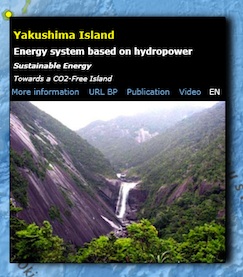Towards a CO2-Free Island.
 Yakushima Island, a World Natural Heritage Site and biosphere reserve located in Kagoshima Prefecture, Japan, is almost completely powered by hydroelectricity. Focusing on this unique island, Kagoshima Prefecture is promoting the “Zero Carbon Emission Island” initiative, which aims to create a developed area where carbon dioxide (CO2) emission is effectively reduced.
Yakushima Island, a World Natural Heritage Site and biosphere reserve located in Kagoshima Prefecture, Japan, is almost completely powered by hydroelectricity. Focusing on this unique island, Kagoshima Prefecture is promoting the “Zero Carbon Emission Island” initiative, which aims to create a developed area where carbon dioxide (CO2) emission is effectively reduced.
Yakushima has been studied as a model area where material recycling and indigenous energy systems could be realized based on the zero-emission concept. Currently, the major energy source for electricity on Yakushima is hydroelectric. The amount of electricity consumed is 58,400 MWh/y (or 211,000 GJ/y). This renewable energy accounts for about 30% of the island’s total energy supply. On this island, hydroelectric, wind, photovoltaic, solar thermal, biomass and waste energy sources are available as renewable energy sources. However, various academic papers have concluded Yakushima possesses enough potential hydropower alone to substitute all energy demands without impacting the environment on the island.
There are four hydroelectric power stations on the island. Three of them belong to a private company, Yakushima Denko Co. Ltd that consumes most of the generated electric energy in the production of silicon carbide. The company also sells some portion of its energy generation to commercial and residential sectors on the island. In 2002 a project called “Yakushima Clean Energy Partners” (Y-CEP) was begun and promoted by Denko. It aimed to create the world’s first complete “hydrogen society” that uses only renewable, clean energy by between 2020 and 2030. The Y-CEP project had several main components that will use surplus hydro-electricity, including the production of hydrogen, compression, storage, and transportation to supply facilities on the island, and this hydrogen would be used for test driving fuel cell and hydrogen-powered vehicles.
In 2004, a hydrogen fueling station was constructed in the town of Miyanoura. This demonstration project was carried out by a collaboration involving a joint university team, Denko and Honda. The university team researched the efficiency of the hydrogen production, the design of an energy supply network on the island, and the public acceptance of a hydrogen society. Denko maintained and operated the station. Hydrogen was produced by on-site water electrolysis and stored as a compressed gas. Honda carried out the driving test runs using their FCX fuel cell vehicle. The produced hydrogen was supplied to the fuel cell vehicles for their testing.
In August 2010, Nissan Motor Co. Ltd and Kagoshima prefecture signed a Zero-Emission partnership to jointly embark on the “Development of a CO2-Free Island” project to create an advanced low-carbon society on Yakushima. The partnership will primarily focus on promoting the widespread adoption of electric vehicles (EVs) on the island and creating an environment where people can safely drive EVs and utilize renewable energy. Already, the prefecture has offered a purchase incentive for EVs by providing subsidies for installation of chargers, while Nissan has started to analyze how to install chargers using drive data analysis technology.
Yakushima will thus serve as a model for Japan who aims to increase the percent age of renewable energy.
Green Island - Yakushima
Related links:
Nissan Zero-Emission Partnership with Kagoshima Prefecture
Renewable Energy and Lifestyle Change – An Example of Yakushima Island’s | Zero Emissions” Initiative, by Hidetaka ICHIKAWA | PDF















